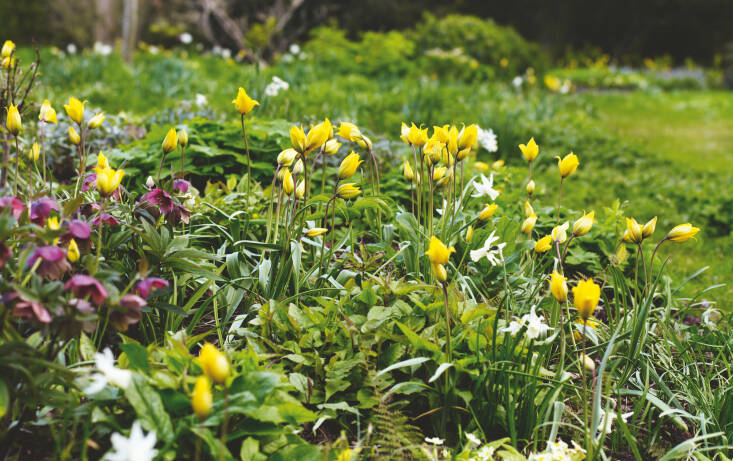Gardeners have been moving away from using pesticides in their gardens at a swift pace in recent years, as awareness of their negative impacts spreads (thank goodness!). However, pesticides aren’t only introduced to the landscape via a homeowner’s application: Pesticides, including neonicotinoids (aka neonics), can also hitch a ride on plants you buy that have been treated with them at the nursery. And when a plant is treated with neonics, every part of it becomes poisonous (and not just to the insects it targets, but also pollinators, pets, and humans, too)—and those pesticides can persist for months and even years.
With the turning of the season, I wondered about the bulbs I hoped to plant this fall: Could I be unknowingly introducing pesticides to my yard?
“Unfortunately, I don’t have a great answer for this,” replied Stephanie Lucas, the director of horticulture for the Madison Park Conservancy, to whom I had reached out because she has lectured on bulbs. “Something like ninety percent of all tulips are still farmed in the Netherlands, and if you think about the amount of pest and disease pressure for that density, it is not at all surprising that farmers will be using every tool in their arsenal to continue to maintain that.” I had hoped that the European Union’s ban on neonicotinoids might mean that bulbs coming from the E.U. were a good bet, but Lucas explains, “The EU has banned a lot of neonicotinoids, but they’re only banned on crops that are considered to be particularly attractive to bees. Eighty percent of crops in the Netherlands remain unaffected by this ban because of that clause.”

Tjerk Dalhuisen, from the Pesticide Action Network (Europe) recently told the U.K. publication Gardens Illustrated, “The mass production of bulbs tends to be really unsustainable. Unfortunately, like in growing many garden plants, very toxic pesticides are used to control pests and fungi. The residues come with the bulbs and in the plants. If you want a lively environment with bees and butterflies, these bulbs don’t belong in your garden or on your balcony. Fortunately, there are organic alternatives, free of synthetic pesticides. Unfortunately, their supply is still limited but growing.”
And it is true that there is a small-but-growing movement of organic bulb suppliers in the U.K., where gardeners can shop at Organicbulbs.com, Organiccatalogue.com, and Organicgardener.co.uk. Stateside, I discovered there are fewer options. Brent & Becky’s is one source several eco-minded gardeners, including Edwina von Gal, the founder of Perfect Earth Project, recommend. The Hudson Valley Seed Co. says that all of the bulbs they sell are “free of neonicotinoids, as well as systemic fungicides and systemic pesticides.” For anyone who purchases bulbs wholesale, A.D.R. Bulbs Inc. says “all bulbs grown at their Dutch facility are neonicotinoid-free.”

On the plus side, Lucas points out that most flowers that grow from bulbs are not favored by pollinators, “Bulbs are cultivated plants. Tulips in particular don’t look remarkably close to their wild cousins…. These plants are so far away from their native place and so altered by human hands that most pollinators don’t recognize them [as food].”
Nonetheless, we do know that neonics can persist in soil for a long time. According to the Xerces Society for Invertebrate Conservation’s paper “How Neonicotinoids Can Kill Bees” residues have been found in woody plants up to six years after soil drench application, an “untreated plants have been found to absorb the residues of some neonicotinoids that persisted in the soil from the previous year.” I could not find research that indicated if neonic-treated bulbs leech into the surrounding soil, so I reached out to the entomologist and ecologist Doug Tallamy, author of Bringing Nature Home, to ask what he knew. Tallamy told me, “We don’t know how far they leach from the plant, so the safest bet is to find a bulb dealer who does not use them.” If you can find organic bulbs, buy them.

We’re not going to tell you to put a halt on your entire bulb order, but what we home gardeners can do is let our bulb suppliers know that we want more organic and pesticide-free bulbs. “Provide the motivation,” says Tallamy. “Let them know there is a market.” Lucas adds that currently, “there isn’t a financial incentive to do product labeling particularly on a product that costs often less than $0.50 per unit retail.” When ordering your bulbs this fall, consider sending an email or making a call to let your preferred vendor know that you want to buy pesticide-free bulbs, or bring it up at the garden center if you’re shopping there. Gardeners have already persuaded bulb catalogs to carry and promote more native bulbs like Camassia, Brodiaea, and Triteleia, perhaps we can help bulb growers move away from pesticides, too?
See also:
(Visited 1 times, 1 visits today)







